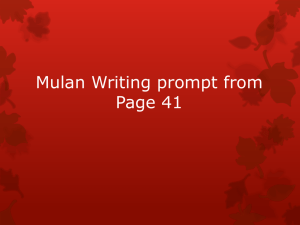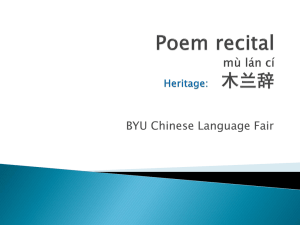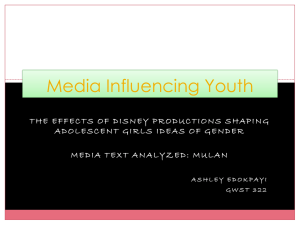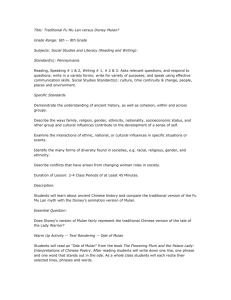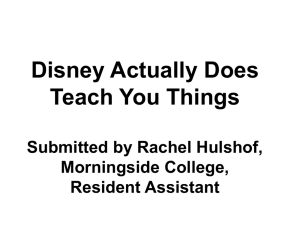Anti-Feminism Through Exotification - Stories-you-sing
advertisement
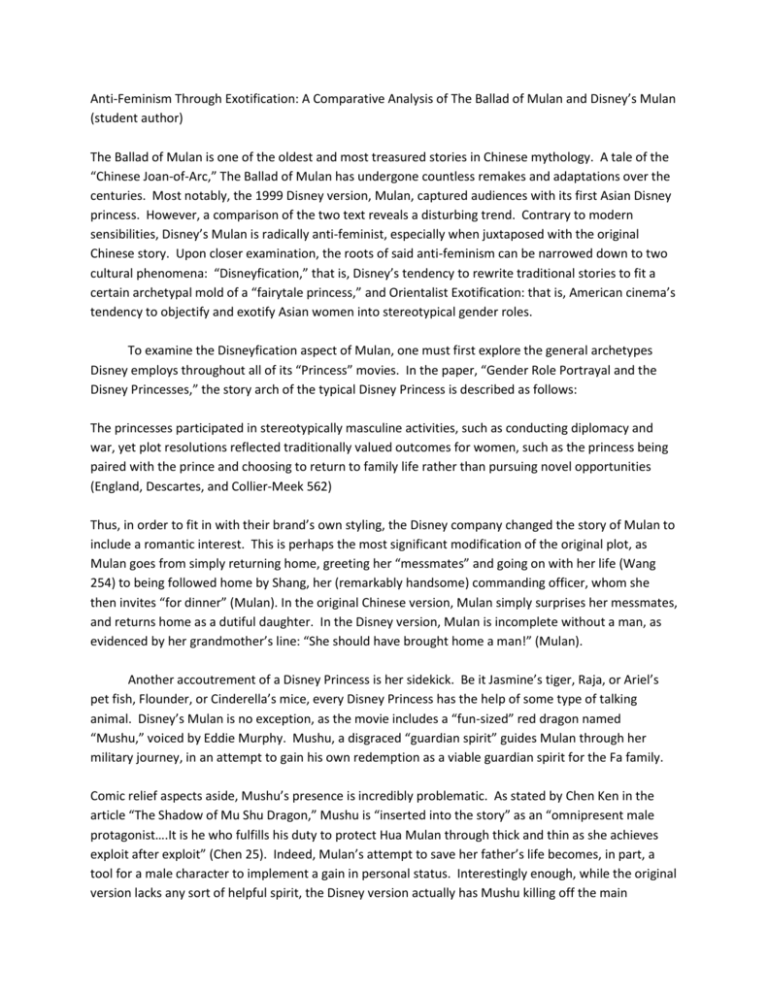
Anti-Feminism Through Exotification: A Comparative Analysis of The Ballad of Mulan and Disney’s Mulan (student author) The Ballad of Mulan is one of the oldest and most treasured stories in Chinese mythology. A tale of the “Chinese Joan-of-Arc,” The Ballad of Mulan has undergone countless remakes and adaptations over the centuries. Most notably, the 1999 Disney version, Mulan, captured audiences with its first Asian Disney princess. However, a comparison of the two text reveals a disturbing trend. Contrary to modern sensibilities, Disney’s Mulan is radically anti-feminist, especially when juxtaposed with the original Chinese story. Upon closer examination, the roots of said anti-feminism can be narrowed down to two cultural phenomena: “Disneyfication,” that is, Disney’s tendency to rewrite traditional stories to fit a certain archetypal mold of a “fairytale princess,” and Orientalist Exotification: that is, American cinema’s tendency to objectify and exotify Asian women into stereotypical gender roles. To examine the Disneyfication aspect of Mulan, one must first explore the general archetypes Disney employs throughout all of its “Princess” movies. In the paper, “Gender Role Portrayal and the Disney Princesses,” the story arch of the typical Disney Princess is described as follows: The princesses participated in stereotypically masculine activities, such as conducting diplomacy and war, yet plot resolutions reflected traditionally valued outcomes for women, such as the princess being paired with the prince and choosing to return to family life rather than pursuing novel opportunities (England, Descartes, and Collier-Meek 562) Thus, in order to fit in with their brand’s own styling, the Disney company changed the story of Mulan to include a romantic interest. This is perhaps the most significant modification of the original plot, as Mulan goes from simply returning home, greeting her “messmates” and going on with her life (Wang 254) to being followed home by Shang, her (remarkably handsome) commanding officer, whom she then invites “for dinner” (Mulan). In the original Chinese version, Mulan simply surprises her messmates, and returns home as a dutiful daughter. In the Disney version, Mulan is incomplete without a man, as evidenced by her grandmother’s line: “She should have brought home a man!” (Mulan). Another accoutrement of a Disney Princess is her sidekick. Be it Jasmine’s tiger, Raja, or Ariel’s pet fish, Flounder, or Cinderella’s mice, every Disney Princess has the help of some type of talking animal. Disney’s Mulan is no exception, as the movie includes a “fun-sized” red dragon named “Mushu,” voiced by Eddie Murphy. Mushu, a disgraced “guardian spirit” guides Mulan through her military journey, in an attempt to gain his own redemption as a viable guardian spirit for the Fa family. Comic relief aspects aside, Mushu’s presence is incredibly problematic. As stated by Chen Ken in the article “The Shadow of Mu Shu Dragon,” Mushu is “inserted into the story” as an “omnipresent male protagonist….It is he who fulfills his duty to protect Hua Mulan through thick and thin as she achieves exploit after exploit” (Chen 25). Indeed, Mulan’s attempt to save her father’s life becomes, in part, a tool for a male character to implement a gain in personal status. Interestingly enough, while the original version lacks any sort of helpful spirit, the Disney version actually has Mushu killing off the main antagonist, Shan Yu, by comically blowing him away via an enormous firecracker. While the idea behind Shan Yu’s death was formed simultaneously by both Mulan and Mushu, Mulan backs off from killing Shan Yu with a sword (which she had just taken from him), shouts “Mushu! Now!” and allows Mushu to explosively fly into Shan Yu, effectively blowing him away (Mulan). In fact, most of the stock Disney comic relief characters are actually more effective in terms of military abilities than Mulan herself. For example, in the combat scenes in the palace, Mulan has several chances to take on Shan Yu herself—even before she somehow ends up on the rooftop, being pursued—not pursuing—the leader of the Huns. Even when she somehow manages to disarm Shan Yu, she instead yells to Shang to do the final act. In fact, the only times Mulan is seen successfully fighting against an enemy, she is simply setting up the comic relief (or other manly characters) up, so that they may hilariously (or epically) kill the enemy. Mulan is not the military equal of the original story; rather, she operates as a quasi Deus Ex Machina for the other characters. In addition to being much more effective in battle, the male characters often objectify women. For example, an entire musical sequence is created over the idea of describing “A Girl Worth Fighting For.” Here, Yao, Chien-Po, and Ling all discuss the attributes a desirable woman must have, but only as a distraction from the tiring march to the battlefield. They discuss physical beauty and domestic attributes, as well as worshipful attitudes—but when Mulan (as Ping) brings up the idea of a woman “who’s got a brain/who always speaks her mind?” the men just scoff in a chorus of “Nah!” (Mulan). Obviously, this is an addition created because of the Disney need for musical numbers—but instead of emphasizing Mulan’s equal status to the men, it only serves to demonstrate her discomfort as well as her innate inability to truly “fit in” with the men. Here, her difference makes her seem weaker, more inept—the sheer heterosexual manhood becomes a part of being an effective solder. Even when Mulan finally wins back her soldier friends’ confidence, they manage to objectify the female gender role. As part of Mulan’s plan, they dress as courtesans—for some reason, it is necessary to put on makeup and robes that are similar to the ones Mulan wears at the beginning of the movie. Mulan herself is devoid of all makeup, but the three men (Chien-Po, Yao, and Ling) all wear makeup and sashes, over-exaggerating themselves as stupidly girly women in order to use the sash and fan to climb the palace’s pillars. In the background, a reprise of “Be a Man” plays, with the implication that Mulan can only truly be a man if the men are acting like women. Their disguises are relatively pointless, especially since Shang suddenly appears with them, fully armed—for some reason, the handsome male lead has no need to make himself out as an “ugly courtesan.” Rather, the Disney trope of a cross-dressing man is used to create humor in a grim strategy sequence as, once again, Mulan directs her male comrades to chase Shan Yu and rescue the Emperor. Finally, the differences in story arc make the original Ballad of Mulan seem like a feminist manifest compared to the Disney-fied version. In the original version, Mulan fights for ten years before her and the other warriors “*win+ their rest” (Wang 251). At the culmination of their labors, The Emperor rewards “the strong in battle” with “prize money a hundred thousand strings” (Wang 251). Mulan politely declines any honors of accolades and “only begs for a camel that can march/A thousand leagues a day,/To take her back to her home” (Wang 254). Her messmates are “startled out of their wits” (Wang 254), but ultimately, the poem ends on the philosophical note of For the male hare has a lilting, lolloping gait, And the female hare has a wild and roving eye; But set them both scampering side by side And who so wise could tell you “This is he”? On the other hand, Disney’s Mulan features a convoluted storyline that involves Mulan’s sex being discovered by a doctor when she injures herself saving her (handsome) commanding officer. When her commanding officer confronts her over the situation, she tearfully states, “I never meant for it to go this far,” (Mulan), implying that she never meant to be fully successful with her military endeavors. When the rest of her warrior friends are marching to the palace, Mulan discovers that Shan Yu was not as dead as she thought. Mulan races to the Forbidden City, intent on stopping Shan Yu from killing the Emperor. Instead of being pleasantly surprised and non-committal, Mulan is forced to aggressively confront her commanding officer, Shang, as well as all of her warrior friends. In a fit of frustration, she gallops away, saying, “You trusted Ping *her alias+; Why is Mulan any different?” (Mulan). Disney’s changes in the plot were necessary to follow the story arc of the typical Disney Princess, in that a heroine must fall down before she can rise. However, because the typical Disney storyline is not particularly in favor of women’s liberation—particularly in terms of liberation from men—The Ballad of Mulan became transformed into a sort of Cinderella story, rather than an accurate portrayal of the Chinese Joan of Arc. But then, as He Zhongshun writes in the Article “What Does the American Mulan look Like?,” “the story of a Chinese girl who joins the army in her father’s place could not guarantee worldwide box-office success on its own, so it had to have some other added elements to attract people.” Disneyfication aside, one has to also address the issue of Orientalist Exoticism found in Mulan. As stated in the article “Sex Acts: Two Meditations on Race and Sexuality,” “Asian women appear on screen as dragon ladies and prostitutes with hearts of gold…distorted representations of ‘lotus blossoms’ or ‘dragon ladies” (Shimizu and Lee 1386). The Disney character of Fa Mulan is no different. Her early onscreen depiction as a dolled up soon-to-be bride is an affront to the original story. Mulan’s first onscreen sequence involves getting dolled up to visit a matchmaker, to “bring honor to her family” (Mulan). The sequence involves a song sung by all the women in the movie. The Chinese version of the lyrics are particularly objectifying: Fa Li and others: If you want to bring honor To your family, you must be elegant, A lustrous beauty” And later: Dresser 1: Be eager to shoulder the domestic Responsibilities Fa Li: Have elegant looks Dresser 2: And a tiny waist All Three: We will be so proud of you (Tang 158) This musical number, accompanied by very the Americanized ideal of “Oriental” music that does not even remotely resemble the musical structure of authentic Chinese songs, manages to confirm both the stereotypes of exotified Asian women: Mulan, the blushing lotus blossom, and the matchmaker, the domineering dragon lady. Part of Mulan’s charm as Disney Princess and Asian woman is her ravishing beauty, pale skin and “tiny waist.” However, as Zhongshun writes, “…it was never stressed in the ancient poem that Mulan was a ravishing beauty” (Zhongshun 23). Furthermore, Zhang Renjie argues that Disney artists “chose to create a Mulan that looks like a Vietnamese” (Renjie 31), versus an authentic-looking Chinese girl. Indeed, dressed up in robes and pale white rice makeup, singing about her “Reflection,” Mulan looks like a tacky Chinatown advertisement, versus a heroine with gumption. The original poem opens not with Mulan being pampered and primped for the matchmaker, but with her weaving. We get insight into her family and all those she loves, instead of a glimpse of female desperation. In the Disney version, Mulan is actually portrayed writing Confucian doctrines on her arm in ink, in order to cheat on her matchmaker’s questions. This also is an affront to feminism; it dictates that women are not capable of remembering doctrines that they have grown up listening to. In the original Ballad of Mulan, Mulan immediately says, “Oh, let me go to the market to buy saddle and horse/And ride with the soldiers to take my father’s place” (Wang 251). Mulan does so, not because she is inept at following her gender role as a “girly girl,” but because she knows that she is the only one capable of taking her father’s place; her brothers are much too young (Wang 251). Her reasons are logical and sound, not made out of passion and a sense of oppression. In The Ballad of Mulan, Mulan does not appear to be oppressed. Rather, she knows how to function in society and ensure that her needs are met, as well as the needs of her family. Second, the Disney version of Mulan places much more emphasis on the ban of women in the army. In the Disney China, gender-crossing is portrayed as a “fatal taboo” (Dong 229). There is no real mention in the original poem of any severe consequences Mulan might face; at the poem’s revelation, her messmates are simply surprised, and she even has to refuse the rewards the Kehan wishes to grant her (Wang 254). Disney has two reasons for dramatizing Mulan’s need for secrecy: it “offers simplistic visions of the exotic other—China—to allay the audience’s fear…*and+ supplements Orientalist fantasies with contemporary youth culture” (Dong 229). In other words, Mulan would not be identifiable and marketable to a Western audience unless she met some of the stereotypical standards that American audiences have for an Asian woman: oppressed, reduced to being a “fair lotus blossom” against her will, and secretive and mysterious. Additionally, in turning Mulan’s filial piety into a sense of oppressed selfidentity, Disney animators created a protagonist that “Caucasian youngster would identify with” (Dong 229). In fact, Disney’s entire production process was fraught with Orientalist ideals and strategies. According to Lan Dong, Disney “sent out a team to journey to China as part of the film’s preproduction plan…to ‘discover’ what Mulan’s life may have been like” (Dong 228), all under the assumption that Mulan, a mythical and legendary figure in Chinese mythology would somehow leave physical imprints in a metaphysical way—a very Exotifying belief. According to Dong, …the places that the Disney production team visited during their trip in order to legitimize the sense of authenticity through physical traveling are not necessarily related to their heroine Mulan, as they claimed. Therefore, the very concept of the “authenticity” that the Disney group searched for is questionable, not to mention the highly Disney-stylish result of the film’s production and distribution.” Here, the Exotification aspect and the Disneyfication aspects of the film finally mesh together. In order to make sure that the movie would appeal to a Western audience, Disney was forced to not only package Mulan as a typical “Disney Princess” (despite not really being royalty of any kind), as well as make sure that Mulan’s image was a familiar “other,” that is, the stereotypical image of an Asian woman. In an attempt to fulfill the demure stereotype of the “lotus blossom,” an image that fits with the “Disney Princess” archetype, the studio changes the motivations behind Mulan’s entire adventure. Rather than filial piety and protectiveness, Mulan becomes motivated by an escape, and then a return, to oppression. At one point, Mulan even says “maybe I didn’t do it to protect my father, bring honor to the Fa family…maybe I did it for myself…so that my reflection would show someone I recognized” (Mulan). While this idea is liberated, its random insertion into the movie makes Mulan appear not only oppressed, but inept at liberating herself in any way. Additionally, when the original poem ends, Mulan wants only to return to her family life and duties, away from the palace and things she sees as unnecessary. In the animated version, Mulan returns to home, only to be followed by Shang, a romantic interest that seems a bit out of place in a story about trying to appear like a man to fight for one’s country. In the original ballad, the Emperor grants Mulan a “fast camel” and means to get home (Wang 254). In the movie, Mulan simply refuses the Emperor, hugs him, and takes off on her horse. The Emperor then sends Shang after her, saying “You don’t meet a girl like that every dynasty” (Wang 254). This demonstration follows the Disney methodology that a woman must be married off, but still refuses to acknowledge Mulan’s true equality among men. If the Emperor truly saw her as the equal of men, why would he automatically assume that she would take Shang as a husband? While refreshing and amusing at times, Disney’s Mulan is not only unfaithful to the original Ballad of Mulan, but it also destroys any sort of feminist qualities the ancient poem maintains. The Ballad of Mulan, with its message of the power of woman through filial piety, becomes lost in a sea of stereotype nonsense. Rather than a symbol of feminism, filial piety, and the power of the Chinese woman, Disney’s Mulan is instead, an exotified, Disneyfied production that presents the audience with the cinematic equivalent of chop suey: Americanized leftovers drenched in Orientalist ideals of what Asian culture should be like. Works Cited 1. Dong, Lan. “Writing Chinese America into Words and Images: Storytelling and Retelling of the Song of Mu Lan.” Lion and the Unicorn 30.2 (2006): 218-33. Web. 3 May 2011. <http://muse.jhu.edu/journals/uni/summary/v030/30.2dong.html>. 2. England, Dawn Elizabeth, Melissa A. Collier-Meek, and Lara Descartes. “Gender Role Portrayal and the Disney Princesses.” Sex Roles 64.7-8 (2011): 555-67. Web. 5 May 2011. 3. Ken, Chen. “The Shadow of Mu Shu Dragon.” Chinese Sociology and Anthropology. 32.2 (1999): 25. Print. 4. Mulan. Dir. Tony Bancroft and Barry Cook.” Disney: 1998, Film. 5. Renjie, Zhang. “Ode to Mulan: Seeing the Animated Film Mulan.” Chinese Sociology and Anthropology. 32.2 (1999): 30-32. Print. 6. Shimizu, Celine Parreñas, and Helen Lee. “Sex Acts: Two Meditations on Race and Sexuality.” Signs30.1 (2004): 1385-1402. Web. 6 May 2011. <http://www.jstor.org/stable/10.1086/421886>. 7. Tang, Jun. “A cross-cultural perspective on production and reception of Disney’S Mulan through its Chinese subtitles.” European Journal of English Studies 12.2 (2008): 149 - 162. Web. 6 May 2011. 8. Wang, Robin. Images of Women in Chinese Thought and Culture. Indianapolis, IN: Hacket Publishing Company, Inc, 2003. 251-54. Print. 9. Zhongshun, He. “What Does the American Mulan Look Like?.” Chinese Sociology and Anthropology. 32.2 (1999): 23-24. Print.

